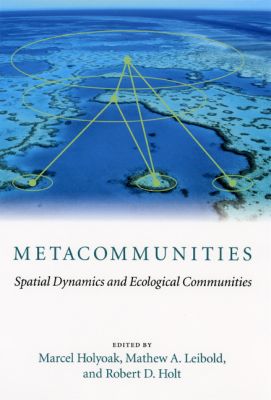Landscapes are often heterogeneous and may also be dynamic either with habitats changing through time (e.g., succession) or entire habitat patches being formed and lost. Ecologists seek to understand how the spatial distribution of habitats, the movement of organisms among habitat areas, and habitat dynamics promote species persistence and the maintenance of biodiversity across a region (a metacommunity). Inter-community boundaries are porous and movement of organisms between local communities can alter local species diversity, community structure and ecosystem processes. The metacommunity concept was first fully described in a paper (Leibold et al. 2004) and edited book (Holyoak et al. 2005).
The initial ideas emphasized the roles of habitat heterogeneity (species sorting), the movement of organisms among habitats of different types (mass effects), and the colonization and extinction of species from habitat areas either with species varying in their traits (patch dynamics, competition-colonization tradeoffs) or all individuals of all species being similar (neutral community dynamics). Empirical evidence suggests that mass effects were common, followed by species sorting, and that patch dynamics and neutral community dynamics were less common. Many systems didn't fit neatly into the four metacommunity types, and they constrained thinking by encouraging classification of metacommunities into these types. The ideas were also constrained in only considering competitive interactions, ignoring differences among species other than in competition or colonization, and so on. Real-world metacommunities also exist in the face of anthropogenic global change, including factors like habitat change and loss, global climate change, changing the distribution of species, pollution and human disturbance. Two major synthetic directions that I have worked on are the effects of climate change (Holyoak and Heath 2015), and temporal dynamics of metacommunities, such as due to disturbance, seasonality and multi-year climate fluctuations (Holyoak et al. 2020).
My early work on spatial dynamics used protozoans and bacteria in laboratory microcosm experiments to test ideas about predator-prey persistence in metapopulations (Holyoak and Lawler 1996a, 1996b). Such theory has proven difficult to test in field systems. Other experimental work investigated persistence and dynamics of simple food webs in habitat patch networks with different numbers of patches and levels of habitat connectivity. In a laboratory community consisting of four species, the top predator showed decreased persistence with fragmentation. However, prey species were more persistent with fragmentation, possibly because predator populations declined (Holyoak 2000). The result that top-predators were more sensitive to fragmentation than prey or intermediate predator species has commonly been observed in field systems. Microcosm work also included more speciose systems, with up to 20 protist species. Kendi Davies led the first metacommunity experiment in which both habitat heterogeneity and habitat connectivity were manipulated together (Davies et al. 2009). When habitat heterogeneity was present more species were maintained in interconnected microcosms than in similar microcosms with the same resources everywhere. Comparisons with homogeneous systems showed that species diversity was elevated by mass effects in heterogeneous systems.
Collaborative work on a large-scale forest fragmentation study with Zhishu Xiao (Institute of Zoology, Chinese Academy of Sciences, Beijing), investigated post-fragmentation changes in species interactions, using network analyses of tree seeds and granivorous rodents (Yang et al. 2018), and frugivores and tree fruits (Li et al. 2020).
I have also participated in work to develop new methods that analyze temporal changes in both species-patch network structure and beta diversity to provide information about how metacommunities change through time and across space (Li et al. 2023). We demonstrated the usefulness of these methods by applying them to both simulated metacommunity data and empirical data from several study systems.

The microcosms used to create patchy interconnected habitats. 30-ml or 100-ml bottles were interconnected using silicon rubber tubes that permitted dispersal of most species. Other microcosms contained large undivided volumes (equivalent unfragmented habitat) or isolated 30-ml or 100-ml volumes (isolated patches).
